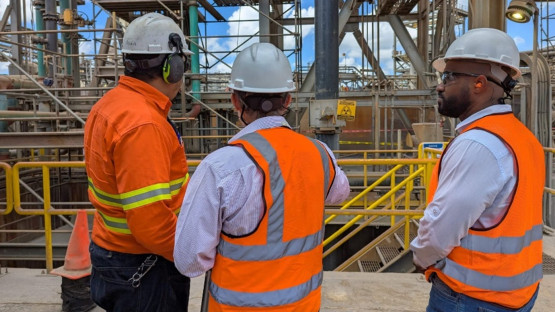IAEA Supports the Dominican Republic to Enhance Radiation Protection of Workers
A technician at the Pueblo Viejo Mine site, operated by Barrick Gold, which produces gold and copper, gives a briefing on the safe operation of a nuclear density gauge used to measure material thickness and moisture content. (Photo: F. C. De Silva/Institute of Radiation Protection and Dosimetry)
The Dominican Republic has further enhanced the radiation safety of workers and workplaces with new regulations and guidance, a recent IAEA safety mission concluded.
“It is the first country to host two full scale IAEA missions on worker protection, highlighting the Dominican Republic’s ongoing commitment to improving worker safety by revising its national policies in line with international safety standards,” said Jizeng Ma, Head of the IAEA Occupational Radiation Protection Unit.
Following the first Occupational Radiation Protection Appraisal Service (ORPAS) mission in 2018, which found the country’s radiation protection measures ‘largely in line’ with IAEA safety standards, the second mission was conducted owing to significant strides in the country to further strengthen worker protection.
The mission took place from 24 March to 1 April 2025 at the request of the Government of Dominican Republic and was hosted by the Ministry of Energy and Mines in Santo Domingo.
The review team, comprising six experts from Argentina, Bosnia and Herzegovina, Brazil, Costa Rica and Uruguay and two IAEA coordinators, assessed the legislative and regulatory infrastructure for occupational radiation protection includingtechnical services such as individual monitoring, calibration of measuring equipment and implementation of radiation protection programmes.
“Our country has been an IAEA Member State since 1957 and identifies radiation safety and nuclear security as one of its seven priority areas for national development in cooperation with the IAEA,” said Jorge Gómez Nú?ez, Head of the Radiation Protection Department at the Ministry of Energy and Mines and ORPAS national coordinator.
The number of occupationally exposed workers in the Dominican Republic is approximately 2500 across medical and industrial sectors.
Strengthening Worker Protection
The team has noted positive advances since 2018, including the introduction of the new guidance for operators on conducting safety assessments for all types of facilities and activities. They also highlighted the proper implementation of radiation control measures and radiation monitoring programmes and that all facilities now have a designated qualified radiation protection officer.
“The national counterparts we met in the Dominican Republic were highly motivated in strengthening occupational radiation protection, which supported the team in providing a valuable appraisal,” said Lucía Valentino, ORPAS mission team leader from the?Nuclear Regulatory Authority of Argentina.
The ORPAS team emphasized the need to further improve worker protection by, for example, establishing a National Dose Registry — which contains the dose records of individuals who are monitored for occupational exposures to ionizing radiation — by harmonizing radiation monitoring programmes across the country and by implementing a national strategy for the education and training of those involved in occupational radiation protection.
“We remain committed to sustaining cooperation between relevant institutions to implement the IAEA’s recommendations in a harmonized way,” added Nú?ez.
This mission was supported by the IAEA’s Technical Cooperation Programme, which assists Member States in the use of nuclear technology for sustainable socioeconomic development.
What are ORPAS missions?
ORPAS missions provide independent reviews of legislation, regulation and practical implementation of radiation protection programmes at facilities and of the functionality of technical service providers regarding occupational radiation protection. The reviews are based on the IAEA International Basic Safety Standards and Safety Guide on Occupational Radiation Protection,?as the international benchmark for protection and safety.
Since its establishment in 2001, ORPAS has supported IAEA member countries in enhancing their occupational radiation protection framework. To date, more than 30 missions have been conducted globally, contributing to the broader effort to protect workers and their workplaces.
Learn more about the IAEA’s Occupational Radiation Protection Appraisal Service (ORPAS) and other IAEA review missions and advisory services.





